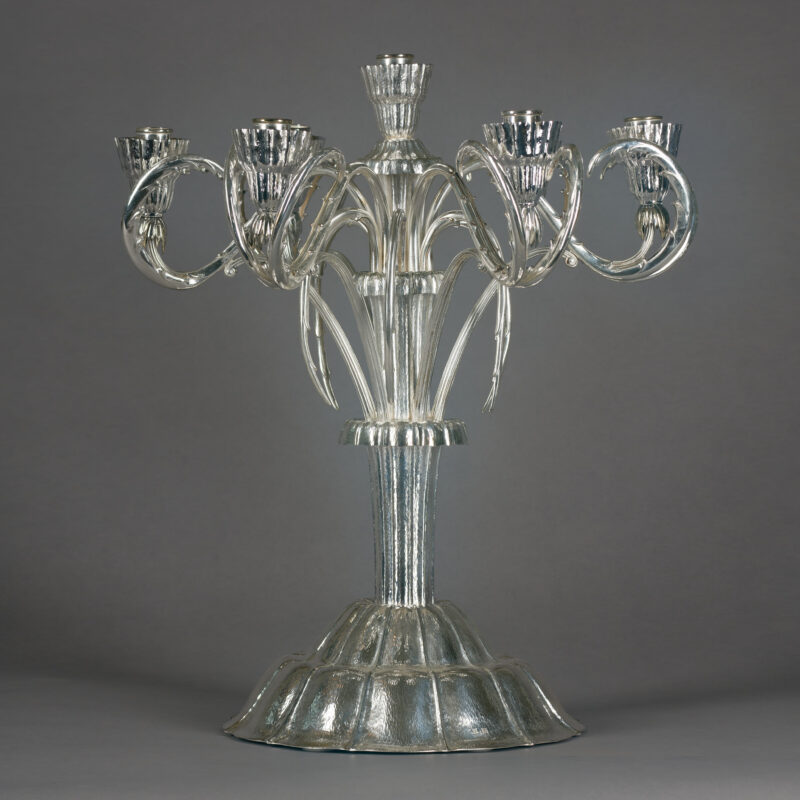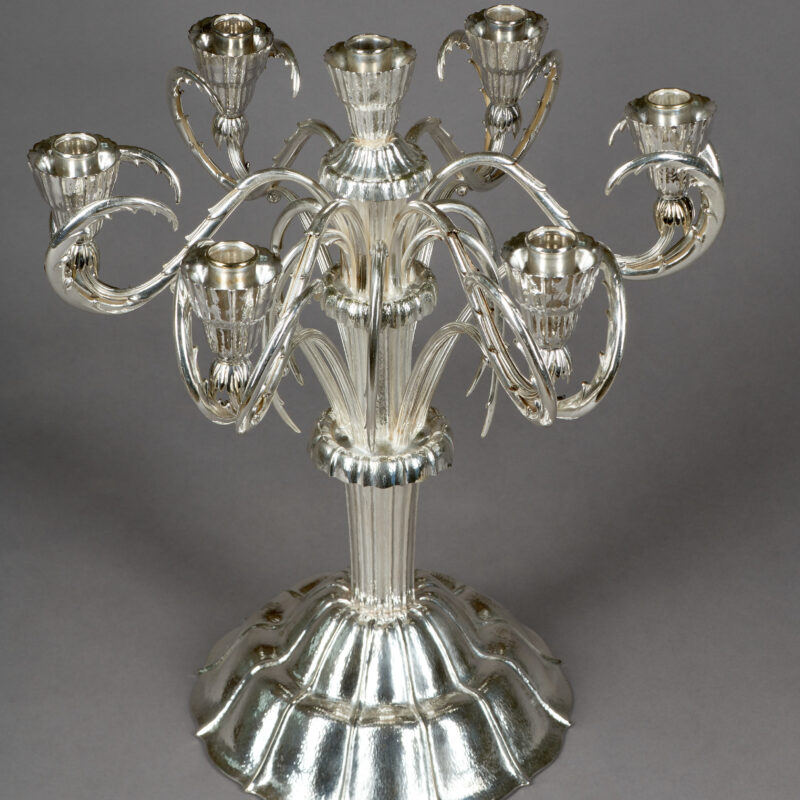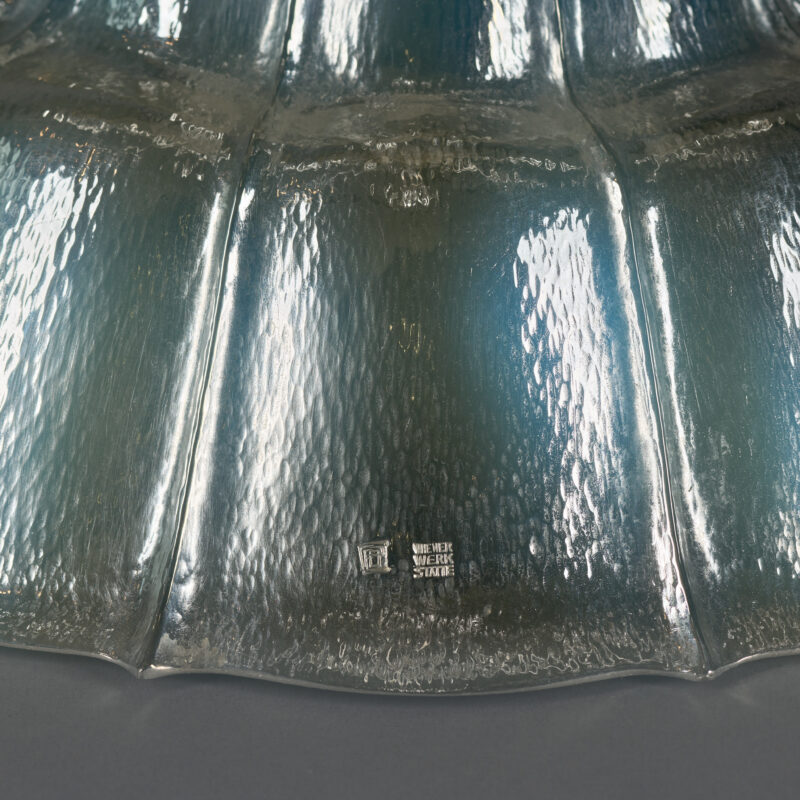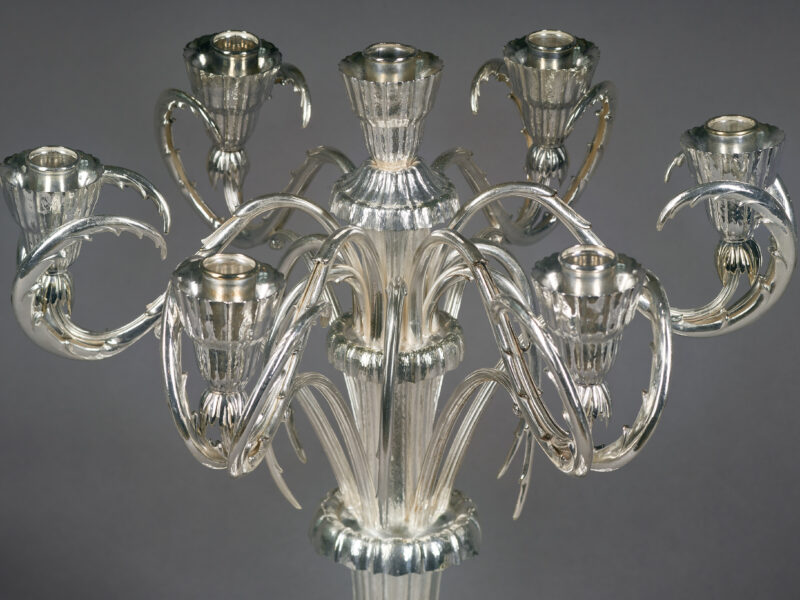
Significant Viennese Ornate Candelabra, Design by Otto Prutscher 1920/21
This nearly Baroque-inspired chandelier was designed by Otto Prutscher around 1920 for the dining room of Leo Nowak in Vienna. It was crafted by the Wiener Werkstätten in a silver-plated execution from hammered brass. Particularly beautiful alongside the elaborate design is the fine appearance of the hammered surface, which covers the entire body of the chandelier, except for the delicate arms.
A similar table centerpiece, also designed by Prutscher in 1920 for the Nowak residence in silver, and executed by the Wiener Werkstätten, exists as a design drawing as well. (University of Applied Arts Vienna, Otto Prutscher 1880 – 1949, Page 40)
Prutscher received several commissions for various chandeliers from Leo and Jakob Nowak, partly for Leo Nowak’s residence in Vienna’s Alsergrund district, at Alserstrasse 28, and also for the furnishings of Jakob Nowak’s house in Vienna Dornbach, at Dornacherstrasse 27. Especially the chandeliers designed by Prutscher in the twenties, including both ceiling and table chandeliers, differ in their approach from Prutscher’s earlier designs. The influence of nature on these designs is unmistakable; they vaguely resemble flowers, intertwined stems with leaves, and the tulip-shaped fittings, or as in our chandelier, the candle nozzles, are evident in the designs of this period. They differ significantly from the abstract geometricism of Prutscher’s earlier designs, although it is worth noting that Prutscher simultaneously designed chandeliers with a very simple formal language combined with textiles for the Melzer company.
Signatures: At the base, we find the monogram “O. P.” as well as the execution mark “WIENER WERKSTÄTTE”
Rarely do we find objects in the art market that combine as many aspects of significant provenance as this ornate candelabra. On the one hand, we have Otto Prutscher, one of the most significant designers of Viennese Art Nouveau and the Secession, and the Wiener Werkstätten, the most significant Viennese producer of that era, as well as Leo Nowak, the commissioner. On the other hand, the Schedelmayer collection, which can rightly be described as the most extensive collection of Otto Prutscher’s works, as well as the many documentation and significant exhibitions such as those at the MAK and the Leopold Museum in Vienna.
This seven-flame candelabra, commissioned for Leo and Jakob Nowak, among others, is depicted and described in the two-volume collection book by Heim & Fritz Schedelmayer, published by the University of Applied Arts Vienna “Otto Prutscher 1880 – 1949 Architect and Designer between Traditions and Modernity Volume 2, p. 168, 169, Figure No. 183:
“…The furnishings for Leo and Jakob Nowak’s residences included particularly impressive candelabras. For the salon of Leo Nowak’s residence in Vienna’s Alsergrund district, they were made of hammered brass and gilded; for the men’s room, of patinated, hammered, and hammered brass, with seasonal putti by Powolny 3; and for the dining room, Prutscher designed an almost Baroque seven-flame ornate candelabra in silver-plated brass → 183. In Jakob Nowak’s house in Vienna-Dornbach 33, the forms were more reminiscent of classicism, all crowned with figurative elements; a two-flame candelabrum with a central figure on the mirror box in the ladies’ lounge, on the mantelpiece in the men’s room 35 and a four-flame candelabrum, silver hammered, on the mantelpiece in the dining room.
The preference of this commissioner for figurative representations was taken into account throughout the furnishings…”
Otto Prutscher (1880 – 1949) belonged to the first generation of students at the Vienna School of Arts and Crafts. His admission in 1897 and his studies under some of the most significant artists of the Vienna Modernism, such as Josef Hoffmann, Koloman Moser, Willibald Schulmeister, and the painter Franz Matsch, profoundly influenced Otto Prutscher’s stylistic development. From 1907 onwards, Otto Prutscher worked for the Wiener Werkstätten. Like Josef Hoffmann, he was both an architect and a designer, and from 1909, he also taught at the Vienna School of Arts and Crafts. He was a member of the most important artist associations such as the Vienna Secession, the Wiener Werkstätten, and the Werkbund, among others. He also collaborated with and worked for the most significant Viennese manufacturers of his era in various fields. His incredible output in architecture and design places him among the greats in the ranks of Viennese architects and designers. Otto Prutscher played a significant role in the development of Viennese Modernism.
Otto Prutscher was not only a busy architect and one of Vienna’s leading artisans at the beginning of the 20th century. In addition to designing several large residential complexes in Vienna, he primarily planned private and commercial buildings as well as coffee houses and their interiors.
He designed interiors for many affluent families in Vienna, which were executed by the most prominent producers of his time, such as Jacob & Josef Kohn, Thonet, Portois & Fix, or J. & L. Lobmeyr. Among other things, he designed furniture, porcelain, glassware, cutlery, metalwork, jewelry, watches, book covers, and textiles for the Wiener Werkstätten association.
His estate, which is now housed at the MAK — Museum of Applied Arts Vienna, includes plans and architectural photographs as well as original designs for furniture and decorative objects. The museum dedicated its own exhibition to him in 2019/2020 (Otto Prutscher. Allgestalter der Wiener Moderne, November 20, 2019 – May 17, 2020).
Reference link, “Otto Prutscher. Universal Designer of Viennese Modernism”, MAK Vienna, click here.
Provenance, documentation, and images of the seven-flame candelabra:
From the Schedlmayer Collection. Literature: Otto Prutscher Archive 1338; Duit, Schedlmayer, Otto Prutscher, Volume 2, p. 168, 169, Fig. No. 183 The Schedelmayer Collection, Exhibition Catalog — Leopold Museum, p. 70; University of Applied Arts, Otto Prutscher, p. 41; MAK, Exhibition Catalog The Price of Beauty, p. 298, M 276, p. 428.
The Schedlmayer Collection. A Discovery!
10.09.2021 – 20.02.2022
The Austrian collector couple Hermi (1941 – 2018) and Fritz Schedlmayer (1939 – 2013) brought together a top-class selection of arts and crafts objects and works of art from the first half of the 20th century. This largely unknown collection will be presented to the public for the first time in autumn of 2021.


